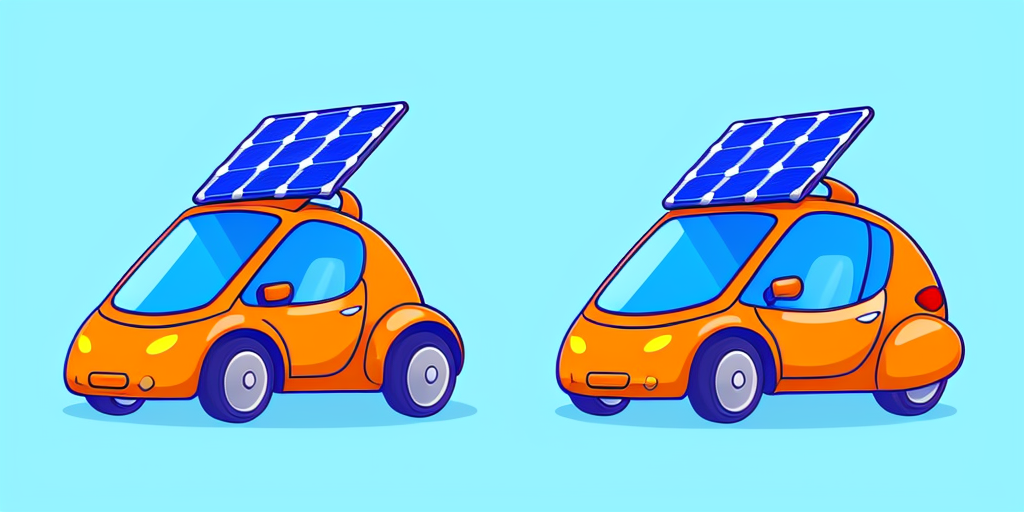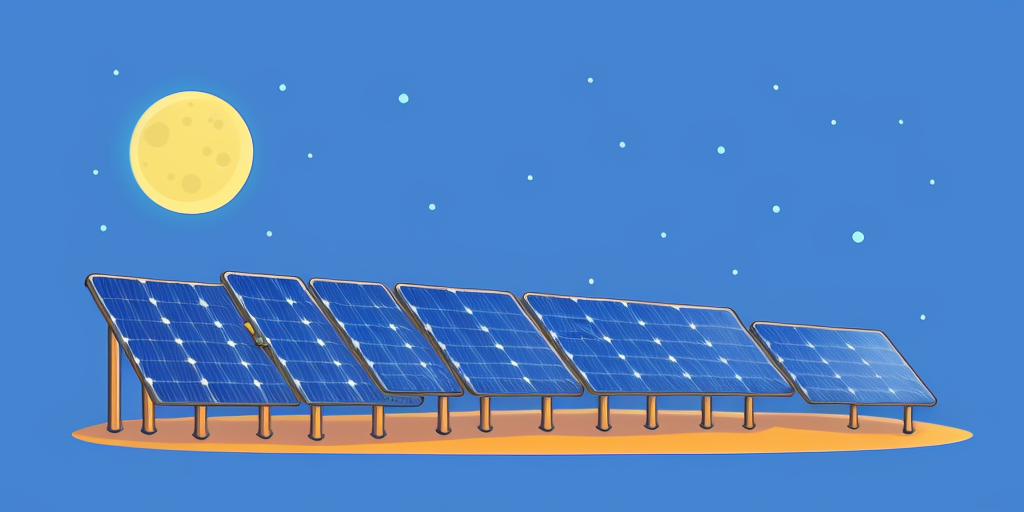Picture this: you’re a kid again, Saturday morning, and your favorite cartoon is on. There’s a mad scientist wielding crazy gadgets that can harness the sun’s power to do unimaginable things. That stuff was so far out there it made E.T. seem like a hometown neighbor. Well, what if I told you we’re not that far off from those morning cartoons? With the latest innovations in solar energy technology, we’re stepping into a world where Dick Dastardly’s solar-powered flying car is as real as your morning coffee. From floating solar farms to space-based solar power, from solar paint to the surprising concept of solar energy production at night, we’ll explore some game-changing innovations in solar technology. Each one paves a unique path into the future of solar energy, a future that might just be closer than we think.
Floating Solar Farms, technically known as “floatovoltaics,” are exactly what they sound—they take advantage of the vast and underused space on top of bodies of water to produce power through solar panels. By occupying unused space on water bodies, floatovoltaics solve one of the major issues of land-based solar installations: the large amount of space required. They also help to conserve water by reducing evaporation, and they could possibly prevent harmful algal blooms by blocking sunlight. As for the challenges, well, water and electricity have never been the best of friends. Therefore, these panels need rigorous safety measures and corrosion-resistant materials. There are also practical issues like access for maintenance and impact on local ecosystems.
While Asia has led the way in the construction of floating solar farms, with China having the two largest projects in the world, followed by Singapore, the concept is slowly spreading to other countries. Despite the fact that floating solar installations account for fewer than 1% of total solar installations worldwide, countries such as Thailand, the United States, and the EU are embracing this technology. Notably, Portugal has built a unique floating solar farm on the Alcaba reservoir, the largest of its kind in Europe.
Imagine cruising down the highway in a vehicle that’s powered by the midday sun. No more gas stations, no more fuel costs, just you, the open road, and an endless supply of energy from above. The dream of solar cars is closer to reality than ever, with firms like Lightyear One, Sono Motors and Aptera Motors on the case. Lightyear One has already launched a prototype solar electric vehicle (SEV) that charges itself with sunlight, promising an impressive 725 km (WLTP) of range on a full charge. And with the solar cells offering a potential 70 km of extra range per day (under the right conditions), range anxiety could become a thing of the past

This technology could potentially revolutionize transportation by significantly reducing our reliance on fossil fuels and lowering carbon emissions. Not only that, the need for charging infrastructure could be reduced, overcoming a major hurdle in the adoption of electric vehicles. However, the road isn’t entirely smooth. There are speed bumps to overcome, such as improving the efficiency of solar panels on cars and working out the cost implications. Despite these, the prospect of a solar car future certainly gets our engines revving.
Windows: they let in light, offer us a view, and now, they might just power our homes too. Solar windows are an innovation that fuses the practical with the extraordinary. They use a type of technology called transparent photovoltaics, which allows windows to convert sunlight into usable energy while remaining see-through. Companies like SolarWindow Technologies, Ubiquitous Energy, and Physee PowerWindow are creating coatings that can be applied to standard windows, converting them into energy-generating surfaces.

These solar windows hold the promise of transforming skyscrapers into vertical power generators, providing a potentially massive boost to urban energy production without the need for additional space. However, there are challenges to tackle. The efficiency of energy conversion needs to be improved, and the cost needs to be comparable to or less than traditional windows for widespread adoption. Even with these hurdles, the day when you can look out your window and know it’s helping power your home feels closer than ever.
Picture this: Gigantic solar panels floating in space, unencumbered by atmospheric interference or the setting of the sun, constantly harnessing the sun’s energy and beaming it back to Earth. Sounds like a sci-fi movie plot, right? Well, welcome to the present because space-based solar power is a real thing under development. The basic idea is to launch massive solar arrays into Geostationary Earth Orbit (GEO), where they can convert sunlight into microwaves and transmit it back to the Earth’s surface for use. The advantage is clear: space-based solar power could provide continuous energy output, unaffected by the day-night cycle or weather conditions.
According to NASA, an SBSP system could capture sunlight 144 times more efficiently than a terrestrial solar farm. The idea is to provide a continuous, large-scale energy source that could power cities or even entire countries. Imagine a world where power blackouts are as outdated as dial-up internet. However, let’s not pack our astronaut suits just yet. There are still many challenges to be addressed, including the high cost of launching and maintaining the arrays, the efficiency of power transmission, and the impact of such installations on the space environment. But, it seems like the sky is no longer the limit when it comes to solar energy innovation.
You’ve probably heard a lot of people tell you how ugly solar panels are. Well, imagine having solar panels on your roof that blend seamlessly with the shingles. Better yet, imagine having solar panels that could match any design you wish. Thanks to Sistine Solar, this isn’t some fancy designer dream; it’s called SolarSkin, and it’s turning heads in the solar industry. SolarSkin is a groundbreaking innovation in the solar industry. It uses a color corrective algorithmic technology to create aesthetic overlays for traditional solar-powered systems. It’s a graphic overlay that can be seamlessly applied to existing solar arrays, completely transforming their visual appearance.
Solar skin technology involves a unique film fitted onto solar panels to mimic the appearance of a roof without disturbing the panel’s efficiency. With SolarSkin, solar panels can blend harmoniously with the surrounding architecture, mimicking the appearance of roofing materials. Not only does it tackle the aesthetic concerns associated with solar panels, but it also enables homeowners and businesses to express their style while going green. Businesses can now incorporate logos, images, text, and custom artwork on their solar panels. The technology achieves an impressive balance between aesthetics and efficiency, preserving up to 99% of the system’s energy generation.
The concept of solar roads is as audacious as it is innovative. Imagine the asphalt you drive on every day, now picture it embedded with solar panels, producing power as you cruise along. Solar Roadways, a company based in the U.S, has already developed a modular system of solar panels that can withstand the weight of semi-trucks.

These solar roads could generate clean energy, reduce the need for above-ground power lines, and even melt snow in colder climates. However, as ambitious as this concept is, there are potholes to fill. Durability, efficiency under real-world conditions, and high costs are some of the most significant challenges to overcome. Not to mention, the result of Solar Roadways’ first pilot project was rather underwhelming, producing less electricity than expected. However, as with any road trip, there are bound to be a few bumps along the way.
From something as visible and tangible as solar roads, let’s shift gears to something completely unseen: invisible solar. This technology, still in its early stages, operates in the near-infrared region, absorbing light that’s invisible to the human eye. The goal is to make solar energy generation unnoticeable, potentially embedding this technology in any surface without affecting its aesthetics.
Despite the potential for ubiquitous energy generation, this tech is still a phantom in the labs. Scientists face challenges in maintaining efficiency at these invisible wavelengths and ensuring these panels can be manufactured cost-effectively. But if they succeed, our future might just have solar energy literally everywhere, and we wouldn’t even see it.
For 2 billion people on Earth, access to clean water is a pressing concern. But using solar power for water purification could provide clean water in a more sustainable way. Among the various methods, solar desalination could be a game changer in this respect. This technology uses solar energy to remove salt and impurities from seawater, producing clean, drinkable water. Given that over 70% of our planet is covered by oceans, the potential is massive. A shining example of this in action is GivePower’s solar water farm in Kiunga, Kenya. This installation uses solar panels that power a desalination system, producing enough water for 35,000 people every day. It’s not just about quenching thirst; it’s about providing a sustainable, green solution to a global problem.
However, solar desalination is not a one-size-fits-all solution. It faces challenges including the disposal of the resultant brine, maintaining the efficiency of the process, and the initial cost of setting up the system. Yet, if these hurdles can be overcome, solar-powered desalination could help bring clean water to millions, making it a beacon of hope in a world where water scarcity is a significant issue.
If someone told you that one day you could paint your house with solar paint and produce electricity, you’d probably think they’ve been inhaling paint fumes. But solar paint is real, and it’s as cool as it sounds. Researchers at RMIT University in Melbourne, Australia, have developed a paint that can absorb water vapor and sunlight, breaking the water down into hydrogen and oxygen – a clean source of energy.

Solar paint contains a compound that acts like silica gel (the stuff you find in those tiny packets in shoe boxes), but with a revolutionary twist: it’s also a semiconductor. When it absorbs sunlight, it catalyzes a reaction splitting the water molecules into hydrogen and oxygen.
This innovative technology could potentially transform any brick or concrete surface into an energy generator, opening up vast new possibilities for renewable energy. Still, it’s early days for solar paint. Challenges like optimizing the hydrogen production rate and finding a practical way to capture and use the hydrogen are still being worked on. So, while we can’t run out to the hardware store just yet, the future of a new coat of power-generating paint is, well, looking pretty bright.
As if our list of solar innovations wasn’t dazzling enough, allow me to introduce solar fabric: textiles weaved with conductive threads capable of capturing solar energy. We’ve seen wearable technology, but this takes it to another level. Now, your clothes might just end up powering your smartphone.
The University of Central Florida is one group conducting pioneering work in this area, developing flexible supercapacitors that store energy within the fabric itself. This is not your grandma’s knitting project. But this technology isn’t limited to clothing. Think bigger, like awnings, tents, or sails. Imagine going camping and having your tent collect power throughout the day, ready to charge your devices at night. Or a sailboat harnessing the wind and the sun as it navigates the open sea.
Like every entry in our solar innovation list, solar fabric faces its unique challenges. The technology needs to be efficient, durable, and able to withstand washing. And let’s not forget that it has to be comfortable and fashionable – we all want to look good while saving the planet, don’t we?
I know, I know. Solar power at night? That’s like selling ice to Eskimos, right? Not exactly. Solar power generation at night is a tantalizing prospect under investigation. This isn’t a solar panel’s version of a night shift, though. Instead, it’s about harnessing the physics of radiative cooling.
The concept relies on a thermoradiative cell which emits infrared radiation towards the cold night sky while generating a small amount of power. It’s not going to rival the output of daytime solar production just yet, but it’s a start and could contribute to a 24/7 solar power solution.

As you’d expect, there are hurdles to jump. The amount of power generated is still quite minimal, and the technology requires more development to become viable commercially. But let’s remember, Rome wasn’t built in a day – or night. The potential of this technology to turn the solar industry into an around-the-clock operation is exciting indeed!
Next, let’s get up close and personal with thin-film solar cells. Thin-film solar cells are made by depositing one or more thin layers of photovoltaic material onto a substrate. The result? You get a solar cell that is lightweight, flexible, and, most importantly, efficient. In fact, the leading thin-film technologies, based on cadmium telluride (CdTe) and copper indium gallium selenide (CIGS), are reaching efficiencies close to or even exceeding traditional silicon-based solar cells.
The potential applications are truly exciting. Imagine solar-powered skins for devices, building-integrated photovoltaics, or even solar-powered clothing. I mean, who wouldn’t want a jacket that could charge their phone? Despite its promising benefits, thin-film solar technology is facing some issues. Manufacturing processes can be more complex and costly, and some thin-film materials, like cadmium, raise environmental concerns. But, like a diamond in the rough, the promise of thin-film technology shines bright. With further refinement, it might just be poised to revolutionize the solar industry.
As we navigate through the 21st century, the quest for greener, more sustainable energy sources is not only a pressing need but also a global conversation that touches every corner of our world. In the face of this massive shift, solar technology is refusing to be left in the dust. Instead, it’s charging ahead, smashing through boundaries and demolishing any preconceived expectations we might have had. From solar cars heralding a greener way to traverse our world, to the subtle power of solar windows transforming our everyday views into potent power generators, each innovation is a clear indication of our forward stride towards a cleaner, greener, and more sustainable future.
However, as exhilarating as these innovations are, it’s important to recognize the hurdles they face. Unique challenges arise in the form of technical issues, cost implications, or efficiency considerations. For these ground-breaking innovations to reach their full potential, it’s necessary to stare down these challenges and tackle them head-on.
The future of solar technology holds immense potential, with advancements like space-based solar power and solar paint paving the way for a greener and more sustainable energy landscape.
Yes, solar powered cars are indeed a reality, with companies like LightYear One pushing the boundaries of automotive innovation by integrating solar panels into their vehicles.
Yes, solar windows have the potential to generate enough electricity to power a building. According to Ubiquitous Energy, if widely implemented, solar windows could revolutionize solar capacity globally, effectively transforming every building into a solar generator and skyscrapers into solar powerhouses. Michigan State University has already installed solar windows in its Biomedical Sciences Building, showcasing the practical application of this innovative technology
Stay a while and read more posts like this
Renewable Energy, Solar Energy, Solar Energy Basics, Solar Technology
“Unlock the Truth: Get the Facts on Solar Energy!” Introduction Solar energy is becoming increasingly popular as a renewable energy source, but there are...
Solar Energy, Solar Energy Basics, Solar Financing, Solar Technology
Investing in solar panels for your home or business has plenty of benefits like saving money, lowering your carbon footprint, and going green. These panels are...
Energy Efficiency, Future of Solar, Solar Energy, Solar Financing, Solar Technology
Indeed, solar panels can help you save money, reduce your carbon footprint, and protect you from astronomical electricity bills. However, before the actual...